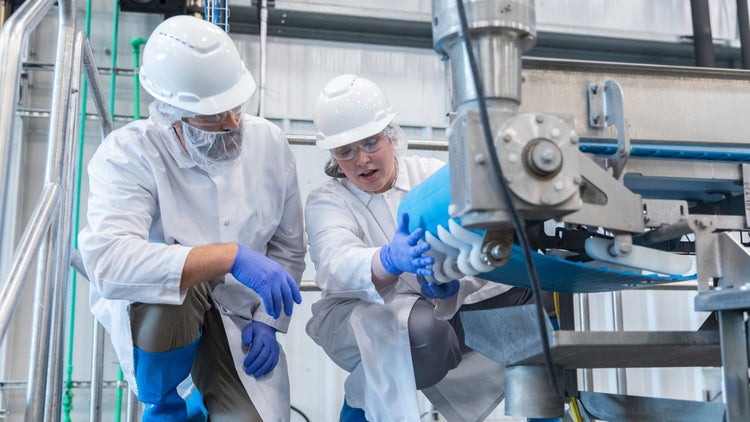Five Steps to Set Your Food Projects Up for Success
Addressing Food Safety in Planning and Startup

- Insights
- June 10, 2024

In food manufacturing, contaminated products cost more than just downtime and profit.
For customers relying on your line to stock their stores or feed their families, your operation’s food safety is their livelihood. It’s the health of their loved ones. It’s a singular, categorical measure of your trustworthiness as a partner.
To them, your food safety defines your brand—period.
That’s why Intralox works so closely with our partners to proactively address causes of foreign material contamination. Having the right technology installed isn’t enough. The best possible outcomes for you and your customers also depend on proper food safety practices in your facilities.
But how do you begin to integrate those practices into your projects? And at what stage?
The short answer is that conversations about food safety protocols must begin before the project does. The only surefire way for line additions to enhance your food safety is to approach that goal holistically, planning for your new solutions to work alongside best practices.
To that end, we’ve created a five-phase guide to food safety from project planning through startup.
A Brief Introduction to Intralox FoodSafe
For you to be successful, you need engaged collaboration from your partners.
Your operation is a complex equation of critical parts, machines, and people, each of which needs careful consideration as part of a unified whole. To help our partners immediately begin that process, we developed The Intralox® FoodSafe™ System.
It starts with reliable technology. We offer the market’s most fault-tolerant products, reducing foreign material contamination risk at the source with high-quality materials and components applied in innovative designs.
Then we bolster those fault-tolerant designs with personnel training—including virtual and in-person options—as well as on-site training with your staff on their new lines.
Finally, we offer a comprehensive suite of services to mitigate risk before, during, and after installation. Offerings such as foreign material risk assessments, like our products, will grow and evolve alongside your goals.
Five of these services in particular should be employed at the beginning of each of your new projects to ensure maximum food safety. They are:
- Specification development
- Conveyor design review and simulation
- Best practices review before and during construction
- Factory acceptance testing
- On-site startup support
Phase One: Specification Development
A crucial first step is developing conveyor design standards and requirements for fabricators.
Without comprehensive specifications, different fabricators will design for different belts, sprocket sizes, and components. If that results in, say, improper belt-to-sprocket engagement, then plastic shavings can begin to show up in your product.
But if your varying fabricators can standardize to your explicit design requirements, you end up with proper fits across your whole project, simplified spare parts management, and universal maintenance protocols.
Intralox Team Tip: The more detailed your specifications, the more consistency you’ll achieve across vendors.
Phase Two: Conveyor Design Review and Simulation
You’ve developed your specifications, but will they work in practice?
Startup isn’t the right time to find out. It’s much easier to change your CAD model than your installed conveyors. Before building, you should test your designs’ performance on a physics-based resource like our Conveyor Design and Simulation (CDS) software.
Our suite of tools and services also includes CalcLab—a robust collection of calculators for conveyance variables—and our belt matrix review to determine the best belt for your application.
Phase Three: Best Practices Review
You’ve made it out of planning with a vetted, thoughtfully engineered design. You’re excited to enter the building stage. Now it’s time to learn how to properly care for your line.
It’s important to connect with your partner on conveyor care best practices both to avoid common mistakes and to increase operational engagement with food safety experts.
For instance, Intralox offers live virtual training sessions on ideal conveyor transport to prevent component damage, proper belt storage to avoid degradation or discoloration, protection of plastic components during construction to prevent embedded debris, and more.
Phase Four: Factory Acceptance Testing
You’re prepared to receive and install your equipment. Before you do, your partner should check it for quality.
Intralox always performs a final review before shipment. We’re also able to provide conveyor assessments on-site at your fabricator’s facility.
However it’s executed, this important check not only confirms that everything works and meets performance expectations. It also provides a final opportunity for changes before production begins.
Phase Five: On-site Startup Support
Your new line has arrived. You can hardly wait to build it and let it run.
If your partner is willing, it’s a good idea to let them observe the installation. Intralox gladly provides this service to our partners, supervising your build through startup and solving problems the moment they arise.
We also ensure belts, sprockets, and conveyor components are set up properly before startup so when your line officially starts running, you’re primed for success.
Become Intralox FoodSafe
Whether you’re launching a new product line, opening a new facility, or doing a quick retrofit, it’s crucial that food safety is a priority from the start.
True food safety isn’t achieved with a single product or practice, but with a holistic approach to your line’s design and upkeep. Our goal is to equip you with the systemic knowledge and tools you need to achieve safe results for the customers who depend on you.

Roberto Mendoza is an Application Engineer at Intralox. He’s part of a team that executes Intralox FoodSafe Conveyor Assessments and Workshops for our customers.